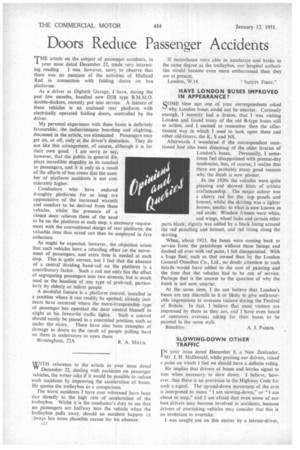Doors Reduce Passenger Accidents
Page 54

If you've noticed an error in this article please click here to report it so we can fix it.
THE article on the subject of passenger accidents, in I your issue dated December 22, made very interest
ing reading I was, however, sorry to observe that there was no mention of the activities of Midland Red in connection with folding doors on bus platforms.
As a driver at Digbeth Garage, I have, during the past few months, handled new D5B type B.M.M.O. double-deckers, recently put into service A feature of these vehicles is an enclosed rear platform with electrically operated folding doors, controlled by the driver.
My personal experience with these buses is definitely favourable; the indiscriminate boarding and alighting, discussed in the article, are eliminated Passengers may get on, or off, onlyat, the driver's discretion. They do not like this arrangement, of course, although it is for
their own good. I am sorry to say, however, that the public in general dis
plays incredible stupidity in its conduct as passengers, and it is only as a result of the efforts of bus crews that the number of platform accidents is not considerably higher.
Conductors who have endured draughty platforms for so long are appreciative of the increased warmth and comfort to be derived from these vehicles, whilst the presence of a • closed door relieves them of the need to be on the platform at each stop, a necessary requirement with the conventional design of rear platform; the valuable time thus saved can then be employed in fare collection.
As might be expected, however, the objection arises that such vehicles have a retarding effect on the movement of passengers, and extra time is needed at each stop. This is quite correct, but I feel that the absence of a central dividing hand-rail on the platform is a contributory factor. Such a rail not only has the effect of segregating passengers into two streams, but is much used as the handiest of any type of grab-rail, partici', lariy by elderly or infirm people.
A doubtful feature is a platform control, installed in a position where it can readily be spotted; already incidents have occurred where the more-irresponsible type of passenger has operated the door control himself to
alight at his favourite traffic lights.. Such a control should surely be placed in a concealed position, such as
tinder the stairs. There have also been examples of damage to doors as the result of people pulling hard on them in endeavours to open them.
Birmingham, 22A R. A. MILLS.
If motorbuses were able to accelerate and brake to the same degree as the trolleybus, our hospital authorities would become even more embarrassed than they are at present.
London, W.I4. SAFETY F1RSI-..'
HAVE LONDON BUSES IMPROVED IN APPEARANCE?
SOME time ago one of your correspondents asked why London buses could not be smarter. Curiously enough, I recently had a dream, that I was visiting London and found many of the old B-type buses still in action, and I seemed to remember then the affectionate way in which I used to look upon these and other old-timers, the K, S and NS.
Afterwards I wondered if the correspondent mentioned had also been dreaming of the older liveries of
London's buses. Personally, I sometimes feel disappointed with present-day tendencies, but, of course, I realize that there are probably many good reasons why the finish is now plainer.
In the 1920s the vehicles were quite pleasing and showed hints of artistic craftsmanship. The major colour was a cherry red for the top panels and bonnet, whilst the skirting was a lighter brown, similar to what is now known as red oxide. Window frames were white, and wings, wheel hubs and certain other parts black; dignity was added by a black lining around the red panelling and bonnet, and red lining along the skirting.
When, about 1923, the buses were coming back to service from the paintshops without these linings and daubed all over with red paint, I felt disappointed. With .a huge fleet, such as that owned then by the London General Omnibus Co., Ltd., no doubt attention to such details would have added to the cost of painting and the time that the vehicles had to be out of service. Perhaps that is the answer to the question of why the finish is not now, smarter.
At the same time, I do not believe that London's buses are any discredit to it or likely to give unfavourable impressions to overseas visitors during the Festival of Britain. In fact, I believe that most visitors are impressed by them as they are, and I have even heard of operators overseas asking for their buses to be painted in the same style.
Bletchley. A. J. PARRIS.




































































































